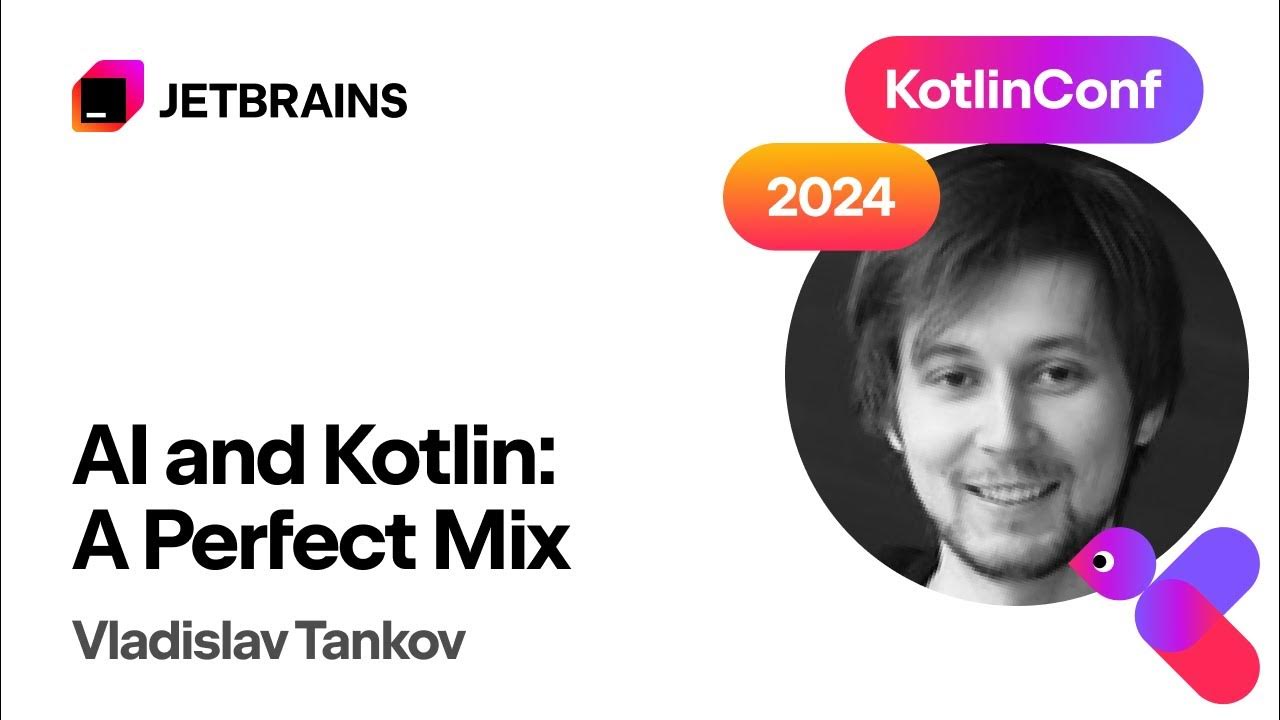Everything you need to know about Kotlin 2.0 🟣
Summary
TLDRJetBrains announced over 80 new features in Kotlin 2.0 at a conference in Denmark. Key updates include extensible data arguments with the 'data R' keyword for cleaner API maintenance, guarded conditions in 'when' blocks to avoid repeating variable names, and context-sensitive resolution for shorter code. Other enhancements are explicit backing fields to reduce boilerplate code, string literals improvements, and union types for error handling. These updates aim to increase developer productivity and code safety.
Takeaways
- 🚀 JetBrains announced over 80 new features in Kotlin 2.0 at a conference in Denmark, showcasing the language's rapid growth.
- 🔑 The introduction of 'data R' keyword allows for extensible data arguments, simplifying the addition of new parameters to functions without overloading.
- 📚 Extensible data arguments help in reducing code duplication and improve the maintenance of APIs by consolidating customization options.
- 🔒 'Guarded conditions' in Kotlin 2.0 enable checking multiple conditions in a 'when' block without repeating the variable name, enhancing code readability.
- 🔄 Context-sensitive resolution allows handling of sealed types or enums more concisely by omitting the base class name when the expected type is known.
- 💥 Kotlin 2.0 restricts destructuring declarations to use variable names that match the property names of the data class, improving code consistency.
- 🛡️ Explicit backing fields reduce boilerplate code by allowing the declaration of a single variable to hold both mutable and immutable states, enhancing encapsulation and immutability.
- 📝 String literals and templates in Kotlin 2.0 now support variable references using the '$' symbol, making string manipulation more flexible.
- 🔄 Union types for errors are introduced in Kotlin 2.0 to handle unchecked casts in a type-safe manner, improving code reliability.
- 🧠 Smart casts in Kotlin 2.0 are enhanced to work after logical operators, allowing for more intuitive and error-free code.
- 🔄 The Kotlin compiler now supports operations between long and integer types more safely, reducing the risk of runtime errors.
Q & A
What is the main topic of the video script?
-The main topic of the video script is the announcement of over 80 new features and improvements in Kotlin 2.0, along with an introduction to some of the most important updates.
What does the 'data R' keyword in Kotlin 2.0 represent?
-The 'data R' keyword in Kotlin 2.0 represents extensible data arguments, which is used to mark a class as a holder of customization arguments, allowing for easier maintenance and functionality extension of APIs.
Why might adding a new parameter to a function like 'lazy column' require a new overload in the current Kotlin version?
-Adding a new parameter to a function like 'lazy column' requires a new overload to maintain backward compatibility and to avoid duplicating documentation for all existing parameters, which can introduce a lot of repetition.
What is the purpose of the 'guarded condition' feature in Kotlin 2.0?
-The 'guarded condition' feature in Kotlin 2.0 is used to check for multiple conditions inside a 'when' block without repeating the state or variable name, simplifying the code and reducing redundancy.
How does the 'context sensitive resolution' update in Kotlin 2.0 improve code conciseness?
-The 'context sensitive resolution' update in Kotlin 2.0 allows handling instances of sealed types or enums directly without repeating the base class name when the expected type is well-known, making the code even shorter.
What is the issue with Kotlin's current destructuring declarations that Kotlin 2.0 aims to address?
-In Kotlin 2.0, the issue with destructuring declarations is that variable names cannot differ from the actual property names of the data class object being destructured. Writing custom variable names results in a compile-time error.
What is the benefit of using explicit backing fields in Kotlin 2.0?
-Using explicit backing fields in Kotlin 2.0 allows encapsulation of the internal state of an object, control over how the state is modified and accessed, and maintaining immutability from an external perspective while allowing controlled modification internally.
How does the update related to string literals and string templates in Kotlin 2.0 improve the functionality?
-The update related to string literals and string templates in Kotlin 2.0 allows referencing variables or properties within a triple-quoted string using a special syntax, making it simpler and more flexible.
What is the significance of introducing Union types for errors in Kotlin 2.0?
-The introduction of Union types for errors in Kotlin 2.0 helps in handling multiple types in a type-safe manner, particularly useful for unchecked casts, allowing the compiler to understand the type and automatically cast to an appropriate value.
How does the smart cast improvement after logical operators in Kotlin 2.0 benefit developers?
-The smart cast improvement after logical operators in Kotlin 2.0 allows the compiler to infer the closest super type of the variable after a logical operator, enabling developers to invoke functions without issues, making the code cleaner and safer.
What is the impact of the simplification of Kotlin constructs in Kotlin 2.0 on code cleanliness?
-The simplification of Kotlin constructs in Kotlin 2.0, such as combining long and integer types with the plus equals operator, allows the compiler to perform necessary conversions automatically, resulting in cleaner and more maintainable code.
Outlines

This section is available to paid users only. Please upgrade to access this part.
Upgrade NowMindmap

This section is available to paid users only. Please upgrade to access this part.
Upgrade NowKeywords

This section is available to paid users only. Please upgrade to access this part.
Upgrade NowHighlights

This section is available to paid users only. Please upgrade to access this part.
Upgrade NowTranscripts

This section is available to paid users only. Please upgrade to access this part.
Upgrade NowBrowse More Related Video
5.0 / 5 (0 votes)





